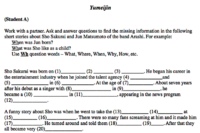
One of the most common mistakes teachers encounter with beginner level university students is with their inability to use the simple past tense correctly. This lesson addresses that issue and it also gets students to use WH-question words correctly. It is called Yumeijin (Famous person). It is best to provide and use information gap activities whenever possible because it brings students together to accomplish a specific task. In this activity, students are presented with information about the lives of two famous Japanese celebrities and in pairs they will work together to determine the missing information. The missing information will elicit responses using the simple past tense and the use of WH-question words. A more detailed description of this activity is listed in the Teacher’s Notes.
The grammar activity is flexible and can be used in classes of all sizes. In the Teacher’s Notes, there is an indication of how much time should be spent on this activity. However, it should be up to the teacher to determine how thoroughly they want to exploit it. The exercise can be used as a warm-up in the beginning of a lesson or at the end as revision. It can also be used as the main focus of a lesson if the instructor so desires. Enclosed in the Teacher’s Notes is a detailed description of what needs to be prepared before the class begins. There are suggestions on how to introduce the activity and encouragement to teachers on how to revise the grammar activities and manipulate them in a way they see fit.
With this exercise, collaborative learning is encouraged. There is a real advantage of working in pairs or groups because interaction among students gives everyone a chance to speak in a non-threatening environment. When working in pairs or groups, students can learn from each other in a natural way and are allowed to be free from the constraints of the classroom. In essence, peer interaction in activities that optimize opportunities for L2 practice, meaning, negotiation, and feedback exchange, are conducive to L2 learning.
To properly utilize this activity, the role of the instructor is to facilitate communication by spending time with each group in the class. If things are going well, students should be encouraged to move on. If things are not going well, the instructor should offer assistance and encouragement. It is wise to keep notes of the common mistakes that occur over and over again so that they can be addressed.
The activity offers an optimal environment for teaching grammar implicitly, but in order to make a lesson complete it is necessary to have feedback sessions and follow-up tasks conducted at the end of each class. It is also necessary to have some sort of evaluation process done in order to ascertain whether the students actually understand the grammar being presented. How to successfully implement corrective feedback sessions, follow-ups, and rubric for evaluating learner awareness is a topic for further discussion.
The purpose of this learner awareness activity is to introduce a grammar focus in a fun and interesting way for L2 learners. The topic is global and of interest particularly to Japanese college level students and it is organized in such a way that allows the students to feel as if they are not actually participating in a grammar activity. According to McLaughlin, Rossman and McLeod (1983), repeated practice with exercises that emphasize practical use of grammatical structures, can lead to the development of automatic routines that formulate into an innate (like?) understanding of the grammatical rules. With a heavy emphasis on interaction and implicit instruction laid out in this activity, this goal can be achieved.
References
McLaughlin, B., Rossman, T., & McLeod, B. (1983). Second Language Learning: An information–processing perspective. Language Learning. 33.
Ma Carmen Perez-Llantada. (2007). New Trends In Grammar Teaching: Issues and applications. Atlantis. 158.
About the Author
Originally from San Diego, Gregg Romano moved to Tokyo Japan in 1998 and lived there until 2005. He taught English at various universities throughout the Tokyo Metropolitan area during that time. Since 2005, he has been residing in Honolulu Hawaii and has been teaching ESOL courses at Kapiolani Community College. He is continually searching for new ways to increase learner performance through implicit target language instruction via the utilization of current global topics and issues. The sharing of ideas and discussions about topics related to ESL is a passion of his.
